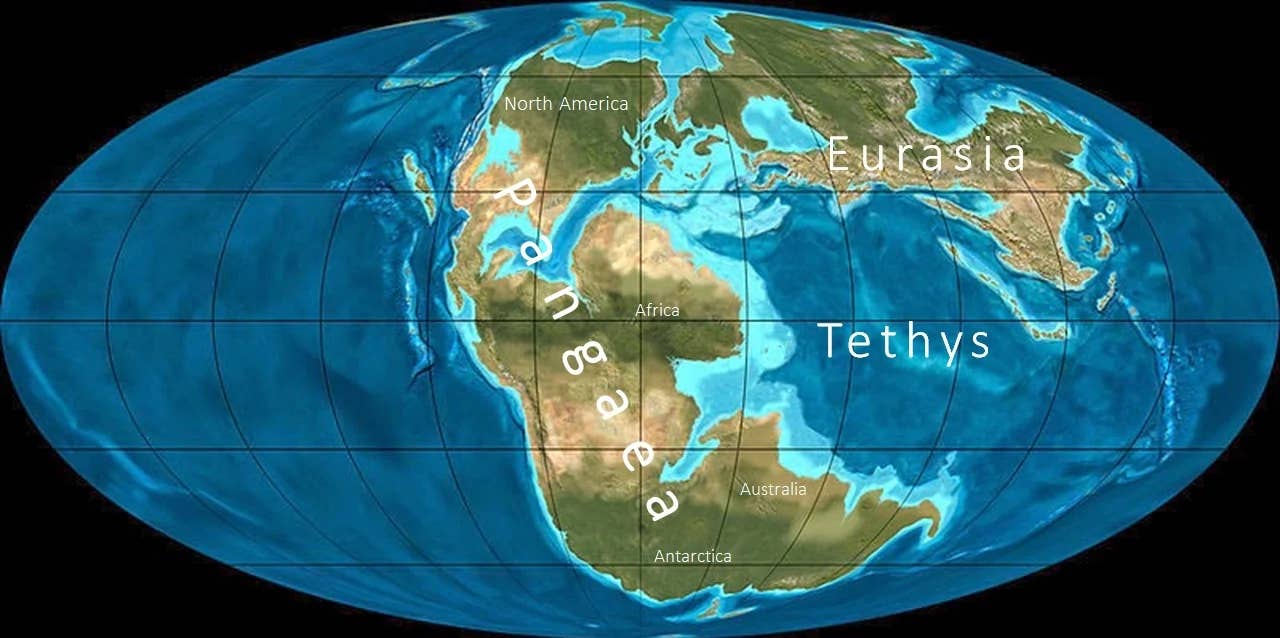Tethys Seaway: The lost ocean that forever changed life on Earth
How the Tethys Seaway’s closure shaped oceans, climate, and the path of evolution—linking Africa, Asia, and early humans.

The ancient closure of the Tethys Seaway reshaped oceans, sparked deserts, and opened migration paths for early humans and animals alike. (CREDIT: CC BY-SA 4.0)
As the Earth's crust shifted and groaned over millions of years, something extraordinary happened beneath the surface. Deep inside the planet, hot rock began rising. Over time, this invisible force shaped continents, guided ocean currents, and even set the stage for animal evolution—including the rise of humans. It all traces back to the slow closure of an ancient ocean known as the Tethys Seaway.
Once stretching between the Atlantic and the Indo-Pacific, this vast seaway shaped the world in powerful ways. Its eventual closure altered global climate, changed marine life, and created new land connections. These events allowed animals to roam and evolve in ways that would never have happened otherwise.
A geologic story told by shifting plates
Around 100 million years ago, during the Late Cretaceous period, Africa began inching toward Eurasia. The Tethys Ocean, caught in between, began to shrink. Over millions of years, this movement sparked a series of tectonic collisions. As the African plate pushed north, smaller continental blocks—Adria, Arabia, and India—broke off at different times and began their own journeys toward Eurasia.
India was the first to drift away from Africa around 90 million years ago. Arabia followed much later, about 25 million years ago. These landmasses didn’t just drift—they were carried by deep forces from within the Earth. Plumes of molten rock surged upward, thinning the crust and forming vast volcanic regions like the Deccan Traps in India and the Afar region in East Africa.
By the time Arabia began its separation from Africa, these internal forces had already raised sections of the Earth's surface. This uplift wasn’t just geological noise—it changed the world.
The rise of land, life, and deserts
Around 30 million years ago, a plume of hot rock from the Earth's mantle pierced the crust beneath what’s now Ethiopia. That plume then pushed its way north, lifting the land across East Africa and Arabia. By 20 million years ago, this rising terrain formed what’s known as the Gomphotherium Land Bridge.
Related Stories
Named after an ancient elephant ancestor, the land bridge stretched across what’s now the Arabian Peninsula and Anatolia. This was more than a change in landscape. It was the end of a 75-million-year isolation for Africa. The land connection allowed animals like elephants, giraffes, cheetahs, and even early human ancestors to move between Africa and Asia.
“This study has relevance to the question of ‘How did our planet change, in general? What are the connections between life and tectonics?’” said Thorsten Becker, a professor at The University of Texas at Austin’s Jackson School of Geosciences and Institute for Geophysics.
Becker co-authored a new review in Nature Reviews Earth & Environment that connects the dots between deep Earth processes and life on the surface. The paper combines previous research with new models developed at the University of Texas and the GFZ Helmholtz Centre for Geosciences in Germany.
Climate changes written in stone
The story isn’t just about shifting animals—it’s also about shifting weather. As the Arabian Peninsula rose, ocean circulation patterns changed. Warm currents were rerouted, making the surrounding land hotter and drier. North Africa, once lush, began turning into desert. The Sahara as we know it may never have formed without the uplift that sealed off the Tethys Seaway.
Meanwhile, in Asia, the uplift helped power a stronger monsoon system. Seasonal rains grew heavier, making regions like Southeast Asia wetter. At the same time, the closing seaway cut off the final link between the Atlantic and Indian Oceans, further changing how heat moved around the globe.
Eivind Straume, the paper’s lead author, said these changes didn’t happen by chance. “The shallow seaway closed several million years before it otherwise likely would have due to these specific processes—mantle convection and corresponding changes in dynamic topography,” he said.
At the time of the study, Straume was a postdoctoral fellow at the Jackson School. He now works at the NORCE Norwegian Research Centre and the Bjerknes Centre for Climate Research. His findings show how even a small shift in timing can reshape evolution.
“If it had been an additional million years before Africa and Asia were connected,” he explained, “the animals that made their way into and out of Africa could have been on a different evolutionary path.” That includes the earliest ancestors of humans.
Seafloor vanishes, species spread
Before the land bridge formed, early human ancestors likely came to Africa from Asia. In Asia, their primate relatives eventually disappeared. But in Africa, their descendants thrived. Once the land bridge emerged, these primates returned to Asia, creating new evolutionary branches.
“It’s an example of how the long-term convective evolution of the planet talks to the evolution of life,” Straume said.
The movement of the Earth’s crust doesn’t happen in isolation. As the Tethys Seaway narrowed and finally closed, it split into what are now the Mediterranean and Arabian Seas. It also brought the Neotethys Ocean to an end. That ancient body of water had long served as a link between the Indian and Atlantic Oceans, and its closure permanently altered global ocean transport.
This shift also marked the rise of the Tethyan orogenic belt, which now includes major mountain ranges from Spain to the Himalayas. As the plates crashed together, they raised peaks and thickened the Earth’s crust. These changes aren’t just relics of the past. The collision between Arabia and Eurasia is still happening today.
In fact, the region remains one of the most geologically active in the world. Earthquakes and continued mountain building reflect the unfinished business of plate tectonics that began tens of millions of years ago.
The deep connection between land and life
Becker calls the review a “compelling—perhaps a little bit provocative—summary” of how Earth’s deep forces have shaped life above. By weaving together data from tectonics, mantle flow, climate models, and fossil records, the team created a full picture of how events below our feet influence everything from deserts to monsoons to migration routes.
While many studies look at one piece of the puzzle, this review brings together a wide range of topics—from evolutionary anthropology to ocean circulation. Its findings also carry a message for future climate modeling. According to the authors, detailed simulations need to better include topographic changes when predicting how continents, climates, and ecosystems evolve.
And there’s still more to uncover. Future research could shed light on other episodes where Earth’s hidden forces steered the course of evolution. The land bridge between Africa and Asia may be just one chapter in a larger story written in stone—and in genes.
Note: The article above provided above by The Brighter Side of News.
Like these kind of feel good stories? Get The Brighter Side of News' newsletter.
Joseph Shavit
Head Science News Writer | Communicating Innovation & Discovery
Based in Los Angeles, Joseph Shavit is an accomplished science journalist, head science news writer and co-founder at The Brighter Side of News, where he translates cutting-edge discoveries into compelling stories for a broad audience. With a strong background spanning science, business, product management, media leadership, and entrepreneurship, Joseph brings a unique perspective to science communication. His expertise allows him to uncover the intersection of technological advancements and market potential, shedding light on how groundbreaking research evolves into transformative products and industries.



